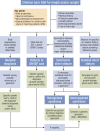International Consensus Guideline on Small for Gestational Age: Etiology and Management From Infancy to Early Adulthood
- PMID: 36635911
- PMCID: PMC10166266
- DOI: 10.1210/endrev/bnad002
International Consensus Guideline on Small for Gestational Age: Etiology and Management From Infancy to Early Adulthood
Abstract
This International Consensus Guideline was developed by experts in the field of small for gestational age (SGA) of 10 pediatric endocrine societies worldwide. A consensus meeting was held and 1300 articles formed the basis for discussions. All experts voted about the strengths of the recommendations. The guideline gives new and clinically relevant insights into the etiology of short stature after SGA birth, including novel knowledge about (epi)genetic causes. Further, it presents long-term consequences of SGA birth and also reviews new treatment options, including treatment with gonadotropin-releasing hormone agonist (GnRHa) in addition to growth hormone (GH) treatment, as well as the metabolic and cardiovascular health of young adults born SGA after cessation of childhood GH treatment in comparison with appropriate control groups. To diagnose SGA, accurate anthropometry and use of national growth charts are recommended. Follow-up in early life is warranted and neurodevelopment evaluation in those at risk. Excessive postnatal weight gain should be avoided, as this is associated with an unfavorable cardiometabolic health profile in adulthood. Children born SGA with persistent short stature < -2.5 SDS at age 2 years or < -2 SDS at 3 to 4 years of age, should be referred for diagnostic workup. In case of dysmorphic features, major malformations, microcephaly, developmental delay, intellectual disability, and/or signs of skeletal dysplasia, genetic testing should be considered. Treatment with 0.033 to 0.067 mg GH/kg/day is recommended in case of persistent short stature at age of 3 to 4 years. Adding GnRHa treatment could be considered when short adult height is expected at pubertal onset. All young adults born SGA require counseling to adopt a healthy lifestyle.
Keywords: GH; SGA; consequences; etiology; genetics; management.
© The Author(s) 2023. Published by Oxford University Press on behalf of the Endocrine Society.
Figures



References
-
- Guilbert JJ. The world health report 2002-reducing risks, promoting healthy life. Educ Health (Abingdon). 2003;16(2):230. - PubMed
-
- Barker DJ, Gluckman PD, Godfrey KM, Harding JE, Owens JA, Robinson JS. Fetal nutrition and cardiovascular disease in adult life. Lancet. 1993;341(8850):938‐941. - PubMed
-
- Barker DJ, Hales CN, Fall CH, Osmond C, Phipps K, Clark PM. Type 2 (non-insulin-dependent) diabetes mellitus, hypertension and hyperlipidaemia (syndrome X): relation to reduced fetal growth. Diabetologia. 1993;36(1):62‐67. - PubMed
-
- Clayton PE, Cianfarani S, Czernichow P, Johannsson G, Rapaport R, Rogol AD. Consensus statement: management of the child born small for gestational age through to adulthood: a consensus statement of the international societies of pediatric endocrinology and the Growth Hormone Research Society. J Clin Endocrinol Metab. 2007;92(3):804‐810. - PubMed

